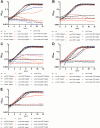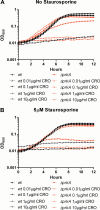Selective pharmacologic inhibition of a PASTA kinase increases Listeria monocytogenes susceptibility to β-lactam antibiotics
- PMID: 24867981
- PMCID: PMC4135996
- DOI: 10.1128/AAC.02396-14
Selective pharmacologic inhibition of a PASTA kinase increases Listeria monocytogenes susceptibility to β-lactam antibiotics
Abstract
While β-lactam antibiotics are a critical part of the antimicrobial arsenal, they are frequently compromised by various resistance mechanisms, including changes in penicillin binding proteins of the bacterial cell wall. Genetic deletion of the penicillin binding protein and serine/threonine kinase-associated protein (PASTA) kinase in methicillin-resistant Staphylococcus aureus (MRSA) has been shown to restore β-lactam susceptibility. However, the mechanism remains unclear, and whether pharmacologic inhibition would have the same effect is unknown. In this study, we found that deletion or pharmacologic inhibition of the PASTA kinase in Listeria monocytogenes by the nonselective kinase inhibitor staurosporine results in enhanced susceptibility to both aminopenicillin and cephalosporin antibiotics. Resistance to vancomycin, another class of cell wall synthesis inhibitors, or antibiotics that inhibit protein synthesis was unaffected by staurosporine treatment. Phosphorylation assays with purified kinases revealed that staurosporine selectively inhibited the PASTA kinase of L. monocytogenes (PrkA). Importantly, staurosporine did not inhibit a L. monocytogenes kinase without a PASTA domain (Lmo0618) or the PASTA kinase from MRSA (Stk1). Finally, inhibition of PrkA with a more selective kinase inhibitor, AZD5438, similarly led to sensitization of L. monocytogenes to β-lactam antibiotics. Overall, these results suggest that pharmacologic targeting of PASTA kinases can increase the efficacy of β-lactam antibiotics.
Copyright © 2014, American Society for Microbiology. All Rights Reserved.
Figures





Similar articles
-
Distribution of PASTA domains in penicillin-binding proteins and serine/threonine kinases of Actinobacteria.J Antibiot (Tokyo). 2016 Sep;69(9):660-85. doi: 10.1038/ja.2015.138. Epub 2016 Jan 13. J Antibiot (Tokyo). 2016. PMID: 26758489 Review.
-
A screen for kinase inhibitors identifies antimicrobial imidazopyridine aminofurazans as specific inhibitors of the Listeria monocytogenes PASTA kinase PrkA.J Biol Chem. 2017 Oct 13;292(41):17037-17045. doi: 10.1074/jbc.M117.808600. Epub 2017 Aug 16. J Biol Chem. 2017. PMID: 28821610 Free PMC article.
-
PASTA kinase-dependent control of peptidoglycan synthesis via ReoM is required for cell wall stress responses, cytosolic survival, and virulence in Listeria monocytogenes.PLoS Pathog. 2021 Oct 8;17(10):e1009881. doi: 10.1371/journal.ppat.1009881. eCollection 2021 Oct. PLoS Pathog. 2021. PMID: 34624065 Free PMC article.
-
Critical role of a ferritin-like protein in the control of Listeria monocytogenes cell envelope structure and stability under β-lactam pressure.PLoS One. 2013 Oct 24;8(10):e77808. doi: 10.1371/journal.pone.0077808. eCollection 2013. PLoS One. 2013. PMID: 24204978 Free PMC article.
-
Do Shoot the Messenger: PASTA Kinases as Virulence Determinants and Antibiotic Targets.Trends Microbiol. 2018 Jan;26(1):56-69. doi: 10.1016/j.tim.2017.06.010. Epub 2017 Jul 19. Trends Microbiol. 2018. PMID: 28734616 Free PMC article. Review.
Cited by
-
The Application of Cinnamon Twig Extract as an Inhibitor of Listeriolysin O against Listeria monocytogenes Infection.Molecules. 2023 Feb 8;28(4):1625. doi: 10.3390/molecules28041625. Molecules. 2023. PMID: 36838612 Free PMC article.
-
The Ser/Thr Kinase PrkC Participates in Cell Wall Homeostasis and Antimicrobial Resistance in Clostridium difficile.Infect Immun. 2019 Jul 23;87(8):e00005-19. doi: 10.1128/IAI.00005-19. Print 2019 Aug. Infect Immun. 2019. PMID: 31085703 Free PMC article.
-
The Listeria monocytogenes PASTA Kinase PrkA and Its Substrate YvcK Are Required for Cell Wall Homeostasis, Metabolism, and Virulence.PLoS Pathog. 2016 Nov 2;12(11):e1006001. doi: 10.1371/journal.ppat.1006001. eCollection 2016 Nov. PLoS Pathog. 2016. PMID: 27806131 Free PMC article.
-
Cinnamonitrile Adjuvants Restore Susceptibility to β-Lactams against Methicillin-Resistant Staphylococcus aureus.ACS Med Chem Lett. 2019 Jul 1;10(8):1148-1153. doi: 10.1021/acsmedchemlett.9b00169. eCollection 2019 Aug 8. ACS Med Chem Lett. 2019. PMID: 31413798 Free PMC article.
-
Distribution of PASTA domains in penicillin-binding proteins and serine/threonine kinases of Actinobacteria.J Antibiot (Tokyo). 2016 Sep;69(9):660-85. doi: 10.1038/ja.2015.138. Epub 2016 Jan 13. J Antibiot (Tokyo). 2016. PMID: 26758489 Review.
References
Publication types
MeSH terms
Substances
Grants and funding
LinkOut - more resources
Full Text Sources
Other Literature Sources
Medical
Miscellaneous

